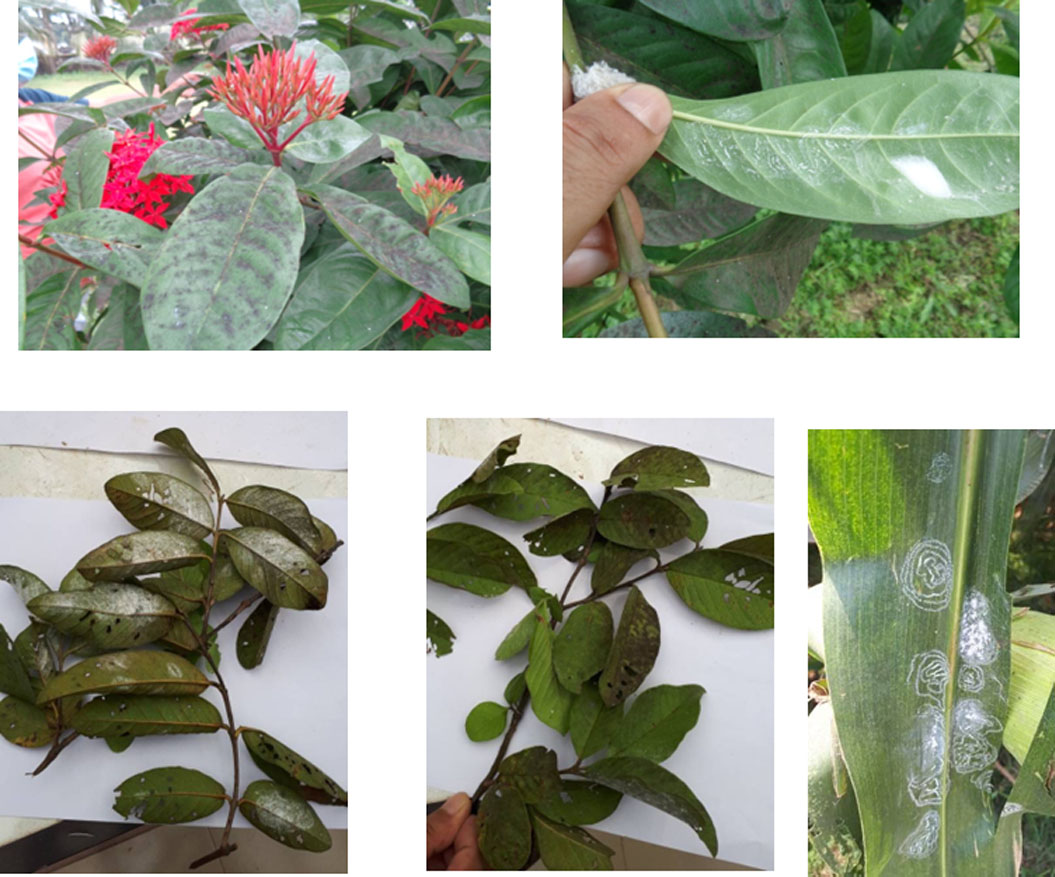Bio-ecology and morpho-molecular characterization of rugose spiralling whitefly and evaluation of some new generation insecticides against this insect under laboratory condition.
The Rugose Spiralling Whitefly, Aleurodicus rugioperculatus (Martin) is a destructive invasive insect pest that was first identified in Bangladesh in 2019. In 2020, we have identified 61 host plants of RSW through a baseline survey study across the country (Das et al., 2023). As it is a new insect in our country, the present study was designed to know its host preference, bio-ecology, species diversity, evaluation of some new generation insecticides in controlling this insect as well as to know the incidence-weather parameters relationship. The findings from basic and applied experiments would be helpful for the relevant researchers, will save our huge coconut industry as well as improve the livelihood of coconut farmers.
• Host plants (native and dwarf varieties of coconut) were collected. • Conducted mass-rearing of RSW under laboratory condition. • Studied the biology of RSW on different coconut saplings at room temperature condition. • Studied the effect of low and high temperature regimes (20, 25, 30, 35, 38 & 40C) on the oviposition and survivability of RSW. This experiment was done under incubator condition. • Collected whitefly samples from 15 AEZs of Bangladesh (left 15 will be covered in the 3rd year) and studied their morphological features. • Evaluated the efficacy of two additives and five new generation insecticides on the mortality of eggs, nymphs and adult RSW. • Studied the relationship between weather parameters and the incidence of RSW under natural condition.
• Host preference: Coconut is the most preferred host plant of RSW that was followed by banana and guava. All three are important fruit crops in our country. Host preference was confirmed through the movement of adult whiteflies from net to host plants, number of egg spirals/10 cm2 leaf area and number eggs/spiral. • Life cycle duration: The lowest, 37.6 ± 0.92 days and the highest 45.4 ± 0.60 days were needed to complete the life cycle of RSW on DJ Sompurna (a coconut variety, Kerala, India) and guava respectively. After coconut, banana is the 2nd preferred host considering all parameters studied (41.8 ± 0.80 days). These findings would be helpful to assess the prevalence of RSW and its appropriate management strategies. • Growth and development: The highest growth and development of eggs, nymphs and adults were found on DJ Sompurna that was followed by Siam blue, Siam green and other host plants. • Effect of high temperature: High temperature worked as a lethal temperature as no eggs survivability was found at 40C temperature. • Species of RSW: Based on morphological features and reviewed literatures, three species were identified. Species are- Rugose Spiralling Whitefly, Aleurodicus rugioperculatus, Bonder’s nesting whitefly, Paraleyrodes bondari and spiralling whitefly, Aleurodicus dispersus. Molecular study will be conducted soon to confirm the species. • Insecticides efficacy: Out of two additives, Fytoclean @ 5.0 ml/L showed better efficacy in controlling eggs and nymphs than that of normal detergent. Out of five tested insecticides, Gladius 10 SC @ 1.0 ml/L and Torit 80WDG @ 0.5 ml/L showed better performance in controlling eggs and nymphs. Importantly, addition of Fytoclean enhanced the efficacy of Torit and Gladius in terms eggs and nymphal mortality. • Population incidence and weather parameters: Maximum temperature and maximum relative humidity had positive correlation while high rainfall had negative correlation on the incidence of RSW. This finding would certainly be helpful to take the appropriate control strategies against RSW in advance.
The rugose spiralling whitefly mostly preferred coconut plants and it has taken the lowest duration on coconut plants to complete its life cycle than that of banana and guava. No eggs are survived at 40 or above 40C temperature. Maximum temperature and maximum relative humidity had positive correlation while high rainfall had negative correlation on the incidence of RSW. Morphologically three species were identified but molecular study is needed to confirm the species. These findings would be helpful to assess the prevalence of RSW and its appropriate management strategies.
This study is not directly related to farmers income, access to markets and establishment of value chain linkage but the results of this study would certainly be helpful for farmers in minimizing RSW infestations and thereby increase productivity. For example, 40C temperature worked as a lethal temperature for eggs survivability. High rainfall potentially reduces the RSW infestations. Fytoclean @ 5.0 ml/L, Gladius @ 1.0 ml/L and Torit 80WDG @ 0.5 ml/L worked well against waxy-coated nymphs. All these findings would be helpful for coconut farmers in increasing productivity by lowering infestation level. Addition of Fytoclean along with Torit 80 WDG and Gladius 10 SC enhanced approximately 20% nymphal mortality.
The nymphs of rugose spiralling whitefly is densely coated with wax and this is the most important obstacles for insecticides penetration. Our coconut farmers repeatedly and injudiciously apply insecticides in controlling RSW but not getting desired results. Dense waxy layer on the nymph might be the cause of less to moderate efficacy of insecticides. This also misuse the insecticides and responsible for health and environmental hazards. Thus, future research is needed to know the structure of wax on nymph and how to remove this thick wax layer to increase insecticide penetration and effectiveness. We should make the modern facilities for the mass rearing of nymphal parasitoids namely, Encarsia guadeloupae. These attempts will ensure insecticides efficacy, will minimize production cost and ensure sustainable control of rugose spiralling whitefly and other whitefly on coconut.

